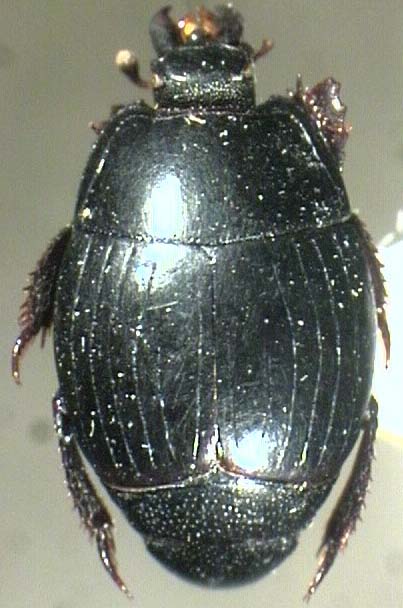 Hister coreanus M. Ohara in Ohara &
Paik, 1998: 15.
Hister coreanus M. Ohara in Ohara &
Paik, 1998: 15.
Hister coreanus M. Ohara, 1998
Hister coreanus M. Ohara in Ohara & Paik, 1998: 15.
Original descripiton (Ohara & Paik, 1998).
Type material. Holotype (EHU). Male. Point-mounted; genitalia dissected; genitalia in balsam on one plastic slide; labeled as follows: 1. "Pyeonganbug-do, Sakuchu (= Mangju), Pong-san (= Bangsan), 22/vi/1997, Kim." 2. "No-9745 M. Ohara." 3. "Holo-type Hister coreanus M. Ohara." Paratypes. One male (Sunchon National Univ.): same data as holotype. One female (EHU): "Korea, Pyeonganbug-do, Shin-eu-ju City, northeast 2 Km, 9/vii/1993, Lee, J. Kha leg." One individual, sex undetermined (EHU): "Corée, Environs de Séoul: 15-June-1919, Edme Gallois, lit de riviere Han."
Description. Body oval, convex, black and shiny; tibiae and antennae reddish brown. Body length (holotype / paratype, male /paratype, female) , PPL 3.88 / 3.71 / 3.98; PEL 3.30 / 3.33 / 3.43; APW 1.05 / 1.05 / 1.09; PPW 2.62 / 2.35 / 2.35; PL 1.36 / 1.29 / 1.26; EL 1.90 / 1.90 / 1.94; EW 2.65 / 2.72 / 2.75; ProW 1.53 / 1.56 / 1.67; ProL 0.61 / 0.58 / 0.58; PyL 0.78 / 0.85 / 0.85; PTL 0.82 / 0.88 / 0.95; MSTL 0.95 / 0.95 / 0.95; MTTL 1.05 / 1.16 / 1.05.
Frontal stria complete and carinate, the anterior portion nearly straight and the lateral portion angulate; supraorbital stria absent; disk flat, finely punctate, the punctures separated by 1 2 times their diameter, the interspace between the punctures covered with alutaceous microsculpture. Mandible with distinct carina on apicolateral side; disk depressed and coarsely punctate.
Pronotal sides (Fig. 6A, B) regularly curved and convergent apically; apical angle round. Marginal pronotal stria complete laterally and slightly interrupted anteriorly on median one-fifth. Outer lateral stria well impressed laterally and shortened on basal one-fifth. Inner lateral stria complete, the median portion feebly crenated. Disk sparsely scattered with fine punctures. A row of coarse punctures present along the posterior margin. Antescutellar area with a short longitudinal impression.
Epipleura of elytra excavated; marginal epipleural and marginal elytral striae well impressed and complete; subhumeral stria wanting (Fig. 6A); oblique humeral stria lightly impressed on basal third; first - third dorsal elytral striae complete, slightly abbreviated basally; the third slightly bent inwardly on basal half; fourth dorsal stria shortened on basal one-eighth and sinuated at apical one-third; fifth dorsal stria present on apical half; sutural stria present on apical two-thirds. Disk of elytra sparsely covered with fine punctures that are separated by about 3 times their diameter.
Propygidium irregularly covered with large, round, shallow punctures that are separated by half to 4 times their diameter, the punctures becoming finer and sparser medially; interstices between the punctures sparsely and finely punctate. Pygidium convex, the anterior area flat; disk sparsely covered with coarse punctures on basal area, the punctures separated by 1 to 2.5 times their diameter and become sparser apically.
Anterior margin of prosternal lobe round; marginal stria complete, another short stria present laterally; disk of lobe convex medially and evenly covered with coarse punctures that are separated by 1 to 3 times their diameter. Prosternal keel convex; carinal stria absent; lateral stria completely impressed and strongly carinate; disk coarsely punctate along lateral stria.
Anterior margin of mesosternum feebly emarginate, its marginal stria distinctly impressed and carinate; another short stria present behind antero-lateral angle on each side; disk sparsely covered with fine punctures that are separated by 4 to 5 times their diameter. Meso-metasternal suture well impressed. Lateral metasternal stria completely impressed and carinate, obliquely and posteriorly extended, the apical end united with an oblique stria that inwardly extends from the middle of the metasterna-metepisternal suture; lateral disk densely covered with large, round and shallow punctures with long hairs, the punctures separated by 0.3 0.7 times their diameter and become smaller medio-posteriorly. Post-mesocoxal stria of metasternum well impressed along posterior of mesocoxa and become more distant from the margin laterally, the lateral portion nearly straight. Punctation of intercoxal disk of metasternum similar to that of the intercoxal disk of mesosternum. Intercoxal disk of first abdominal sternum with complete stria laterally, the stria usually interrupted and bent at middle.
Protibia with 4 denticles on outer margin, the basal one small and apical one with 2 spinula. Meso- and metatibiae with 2 rows of 8 10 long and stout spinula on outer margin.
Male genitalia as shown in Fig. 9. Aedeagus slender; lateral sides of parameres slight divergent apically, then strongly convergent at apical third of parameres; process on midline of ventral side weak; ratio of parameres length to basal piece length about 2.4.
Distribution. Korea.
Remarks. This new species is very similar to H. sedakovii. See
also remarks of sedakovii.